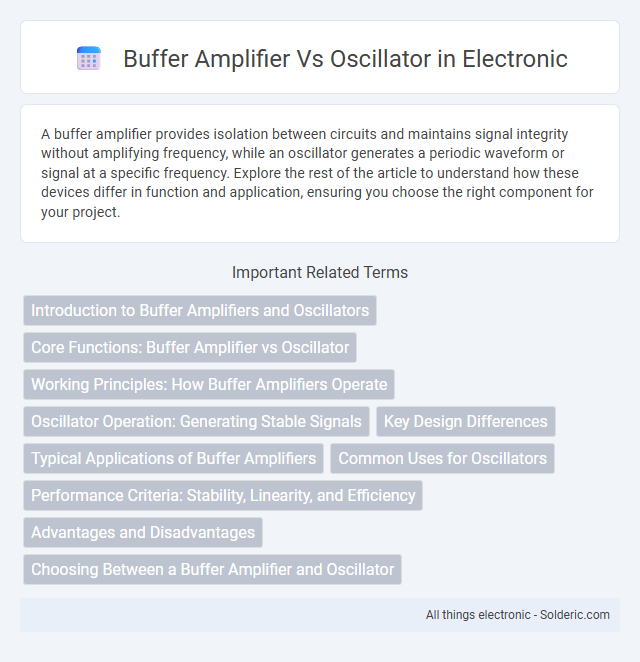A buffer amplifier provides isolation between circuits and maintains signal integrity without amplifying frequency, while an oscillator generates a periodic waveform or signal at a specific frequency. Explore the rest of the article to understand how these devices differ in function and application, ensuring you choose the right component for your project.
Comparison Table
| Feature | Buffer Amplifier | Oscillator |
|---|---|---|
| Primary Function | Impedance matching, signal isolation | Generates continuous periodic waveforms |
| Output Signal | Amplified replica of input | Self-sustained AC signal (sine, square, etc.) |
| Feedback | Usually no feedback or unity gain | Positive feedback to sustain oscillations |
| Applications | Signal buffering, impedance matching, isolation | Clock generation, waveform synthesis, RF signals |
| Frequency Stability | Does not generate frequency, stable for passing signals | Frequency depends on circuit components; frequency stability critical |
| Gain | Unity or slightly greater | Greater than or equal to unity |
| Energy Source | Driven by input signal | Requires external power to sustain oscillations |
Introduction to Buffer Amplifiers and Oscillators
Buffer amplifiers provide impedance matching and signal isolation by offering high input impedance and low output impedance, ensuring minimal signal distortion and power loss in electronic circuits. Oscillators generate continuous periodic waveforms such as sine, square, or triangle waves, serving as essential components in clock generation, signal modulation, and frequency synthesis. Both devices play crucial roles in analog and digital electronics, with buffer amplifiers stabilizing signal levels and oscillators enabling timing and waveform generation.
Core Functions: Buffer Amplifier vs Oscillator
A buffer amplifier primarily functions to isolate different stages of a circuit, providing impedance matching and preventing signal loading while maintaining voltage levels without distortion. In contrast, an oscillator generates continuous periodic waveforms, such as sine, square, or triangle waves, by converting DC power into an AC signal with a specific frequency. The core function of a buffer amplifier is signal integrity preservation, whereas the oscillator's core function is stable frequency generation for timing or carrier signals.
Working Principles: How Buffer Amplifiers Operate
Buffer amplifiers operate by providing high input impedance and low output impedance to prevent signal loss and loading effects in circuits, effectively isolating different stages. They use voltage follower configurations, where the output voltage closely matches the input voltage without amplification of signal amplitude. Unlike oscillators, which generate periodic signals using feedback loops, buffer amplifiers maintain signal integrity and stability without introducing frequency components.
Oscillator Operation: Generating Stable Signals
Oscillators generate stable signals by producing continuous periodic waveforms through feedback and frequency-determining components, such as crystals or LC circuits. Buffer amplifiers isolate the oscillator from load variations, maintaining signal integrity and preventing frequency shifts. This combination ensures reliable oscillation with consistent amplitude and frequency stability critical in communication and signal processing applications.
Key Design Differences
Buffer amplifiers prioritize high input impedance and low output impedance to prevent signal loading and enable signal isolation without gain, while oscillators are designed to produce continuous periodic waveforms by incorporating feedback loops with specific frequency-determining components like inductors and capacitors. Buffer amplifier circuits often feature unity gain configurations and avoid phase shifts, whereas oscillators require precise phase shift and gain conditions to sustain oscillations. The stability of buffer amplifiers contrasts with the inherent frequency-selective instability of oscillators, essential for waveform generation.
Typical Applications of Buffer Amplifiers
Buffer amplifiers are commonly used in applications requiring impedance matching, signal isolation, and voltage buffering to prevent signal degradation between stages. They are essential in analog-to-digital conversion systems, sensor signal conditioning, and audio equipment to ensure stable voltage levels and minimize loading effects. Their high input impedance and low output impedance make them ideal for driving subsequent circuit blocks without affecting the preceding signals.
Common Uses for Oscillators
Oscillators are commonly used in signal generation for communication systems, clock generation in digital circuits, and audio frequency generation in sound systems. They produce continuous periodic waveforms such as sine, square, or triangle waves essential for timing and waveform synthesis. Their precision and stability make them indispensable in radio frequency transmitters, microcontrollers, and electronic test equipment.
Performance Criteria: Stability, Linearity, and Efficiency
Buffer amplifiers excel in stability by offering consistent gain without oscillation, ensuring linearity through minimal signal distortion and high input-output impedance isolation, which enhances efficiency by preventing signal loading. Oscillators prioritize stability by maintaining consistent frequency output with low phase noise, often sacrificing absolute linearity due to feedback-induced waveform shaping, while achieving efficiency through self-sustaining energy conversion within resonant circuits. Performance optimization in buffer amplifiers targets linear amplification and input-output isolation, whereas oscillator design balances frequency stability and energy efficiency at the potential cost of strict linearity.
Advantages and Disadvantages
A buffer amplifier offers high input impedance and low output impedance, ideal for isolating stages without signal distortion, but it cannot generate signals independently. Oscillators provide continuous periodic waveforms essential for clock generation and communication systems, yet they require precise component tuning and can introduce noise. In contrast, buffer amplifiers excel in signal integrity preservation, while oscillators are indispensable for frequency generation despite their complexity.
Choosing Between a Buffer Amplifier and Oscillator
Selecting between a buffer amplifier and an oscillator depends on the required function in your circuit; buffer amplifiers provide impedance matching and signal isolation without frequency generation, while oscillators create continuous periodic signals at specific frequencies. Buffer amplifiers maintain signal integrity and reduce loading effects between stages, making them ideal for signal conditioning. Oscillators, on the other hand, are essential for generating clock signals, carrier waves, or timing references in communication and control systems.
buffer amplifier vs oscillator Infographic

 solderic.com
solderic.com